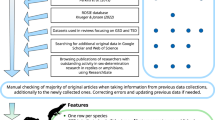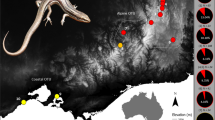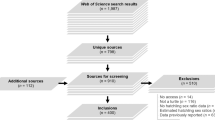Abstract
Sex determination is a fundamental biological process, yet its mechanisms are remarkably diverse1,2. In vertebrates, sex can be determined by inherited genetic factors or by the temperature experienced during embryonic development2,3. However, the evolutionary causes of this diversity remain unknown. Here we show that live-bearing lizards at different climatic extremes of the species’ distribution differ in their sex-determining mechanisms, with temperature-dependent sex determination in lowlands and genotypic sex determination in highlands. A theoretical model parameterized with field data accurately predicts this divergence in sex-determining systems and the consequence thereof for variation in cohort sex ratios among years. Furthermore, we show that divergent natural selection on sex determination across altitudes is caused by climatic effects on lizard life history and variation in the magnitude of between-year temperature fluctuations. Our results establish an adaptive explanation for intra-specific divergence in sex-determining systems driven by phenotypic plasticity and ecological selection, thereby providing a unifying framework for integrating the developmental, ecological and evolutionary basis for variation in vertebrate sex determination.
This is a preview of subscription content, access via your institution
Access options
Subscribe to this journal
Receive 51 print issues and online access
$199.00 per year
only $3.90 per issue
Buy this article
- Purchase on Springer Link
- Instant access to full article PDF
Prices may be subject to local taxes which are calculated during checkout



Similar content being viewed by others
References
Bull, J. J. The Evolution of Sex Determining Systems (Benjamin/Cummings Inc., 1983)
Valenzuela, N. & Lance, V. Temperature-Dependent Sex Determination in Vertebrates (Smithsonian Books, 2004)
Janzen, F. J. & Phillips, P. C. Exploring the evolution of environmental sex determination, especially in reptiles. J. Evol. Biol. 19, 1775–1784 (2006)
Radder, R., Pike, D. A., Quinn, A. E. & Shine, R. Offspring sex in a lizard depends on egg size. Curr. Biol. 19, 1–4 (2009)
Quinn, A. E. et al. Temperature sex reversal implies sex gene dosage in a reptile. Science 316, 411–416 (2007)
Crews, D. & Bull, J. J. Mode and tempo in environmental sex determination in vertebrates. Semin. Cell Dev. Biol. 20, 251–255 (2009)
Warner, D. A. & Shine, R. The adaptive significance of temperature-dependent sex determination in a reptile. Nature 451, 566–569 (2008)
Uller, T., Pen, I., Wapstra, E., Beukeboom, L. W. & Komdeur, J. The evolution of sex ratios and sex-determining systems. Trends Ecol. Evol. 22, 292–297 (2007)
Charnov, E. & Bull, J. J. When is sex environmentally determined? Nature 266, 828–830 (1977)
Conover, D. O. Adaptive significance of temperature-dependent sex determination in a fish. Am. Nat. 123, 297–313 (1984)
Warner, D. A., Uller, T. & Shine, R. Fitness effects of the timing of hatching may drive the evolution of temperature-dependent sex determination in short-lived lizards. Evol. Ecol. 23, 281–294 (2009)
Conover, D. O. & Heins, S. W. Adaptive variation in environmental and genetic sex determination in a fish. Nature 326, 496–498 (1987)
Wapstra, E. & Swain, R. Geographic and annual variation in life history traits in a temperate zone Australian skink. J. Herpetol. 35, 194–203 (2001)
Wapstra, E. et al. Maternal basking behaviour determines offspring sex in a viviparous reptile. Proc. R. Soc. Lond. B 271, S230–S232 (2004)
Olsson, M. et al. Sexual dimorphism in lizard body shape: the roles of sexual selection and fecundity selection. Evolution 56, 1538–1542 (2002)
Atkins, N. Parental Effects in Two Species of Viviparous Lizards: Niveoscincus microlepidotus and N. ocellatus. PhD thesis, University of Tasmania. (2007)
Wapstra, E., Swain, R. & O’Reilly, J. M. Geographic variation in age and size at maturity in a small Australian viviparous skink. Copeia 3, 646–655 (2001)
Bulmer, M. G. & Bull, J. J. Models of polygenic sex determination and sex ratio control. Evolution 36, 13–26 (1982)
van Dooren, T. J. M. & Leimar, O. The evolution of environmental and genetic sex determination in fluctuating environments. Evolution 57, 2667–2677 (2003)
Leimar, O., Hammerstein, P. & van Dooren, T. J. M. A new perspective on developmental plasticity and the principles of adaptive morph determination. Am. Nat. 167, 367–376 (2006)
West-Eberhard, M.-J. Developmental Plasticity and Evolution (Oxford University Press, 2003)
Adolph, S. C. & Porter, W. P. Growth, seasonality, and lizard life histories: age and size at maturity. Oikos 77, 267–278 (1996)
Cadby, C. D. et al. Multi-scale approach to understanding climate effects on offspring size at birth and date of birth in a reptile. Integr. Zool. 5, 164–175 (2010)
Ospina-Alvarez, N. & Pifferer, F. Temperature-dependent sex determination in fish revisited: prevalence, a single sex ratio response pattern, and possible effects of climate change. PLoS ONE 3, E2837 (2008)
Uller, T. & Badyaev, A. V. Evolution of “determinants” in sex determination: a novel hypothesis for the origin of environmental contingencies in avian sex-bias. Semin. Cell Dev. Biol. 20, 304–312 (2009)
Wapstra, E. et al. Climate effects on offspring sex ratio in a viviparous lizard. J. Anim. Ecol. 78, 84–90 (2009)
Neaves, L. et al. Embryonic gonadal and sexual organ development in a small viviparous skink, Niveoscincus ocellatus. J. Exp. Zool. 305A, 74–82 (2006)
Melville, J. & Swain, R. Evolutionary relationships between morphology, performance and habitat openness in the lizard genus Niveoscincus (Scincidae: Lyosomaniae). Biol. J. Linn. Soc. 70, 667–680 (2000)
Acknowledgements
Funding was provided by the Australian Research Council to E.W., T.U. and I.P. (DP0877948), by the Hermon Slade Foundation to E.W., T.U. and I.P., and by the Wenner-Gren Foundations to T.U.
Author information
Authors and Affiliations
Contributions
T.U., I.P. and E.W. initiated, planned and coordinated the project; E.W. collected field and experimental data, assisted by G.M.W.; T.U., G.M.W. and I.P. analysed data and generated parameter estimates for the model; I.P., B.F., A.H. and T.U. constructed the model and analysed its outcome; T.U. and I.P. wrote the paper with input from all other authors.
Corresponding author
Ethics declarations
Competing interests
The authors declare no competing financial interests.
Supplementary information
Supplementary Information
This file contains Supplementary Text, additional references, Supplementary Tables 1-3 and Supplementary Figures 1-6 with legends. (PDF 1684 kb)
Rights and permissions
About this article
Cite this article
Pen, I., Uller, T., Feldmeyer, B. et al. Climate-driven population divergence in sex-determining systems. Nature 468, 436–438 (2010). https://doi.org/10.1038/nature09512
Received:
Accepted:
Published:
Issue Date:
DOI: https://doi.org/10.1038/nature09512
This article is cited by
-
Mathematical modelling to assess the impact of stress on temperature-dependent sex determination in teleost fish
Journal of Applied Mathematics and Computing (2024)
-
Evolution of sex determination in crustaceans
Marine Life Science & Technology (2023)
-
High elevation increases the risk of Y chromosome loss in Alpine skink populations with sex reversal
Heredity (2021)
-
Sex determination systems in reptiles are related to ambient temperature but not to the level of climatic fluctuation
BMC Evolutionary Biology (2020)
-
Sex ratios and bimaturism differ between temperature-dependent and genetic sex-determination systems in reptiles
BMC Evolutionary Biology (2019)
Comments
By submitting a comment you agree to abide by our Terms and Community Guidelines. If you find something abusive or that does not comply with our terms or guidelines please flag it as inappropriate.



